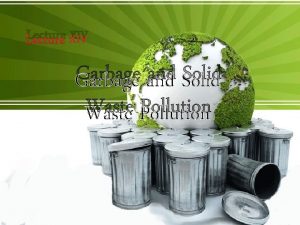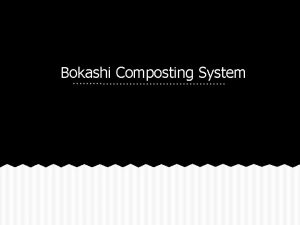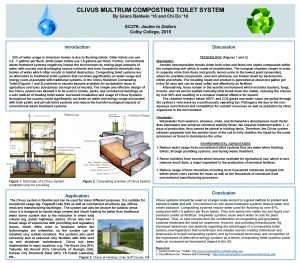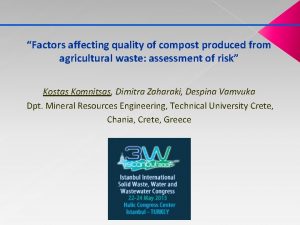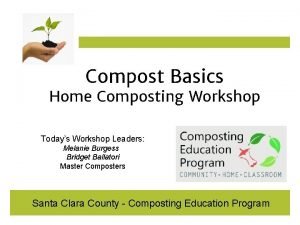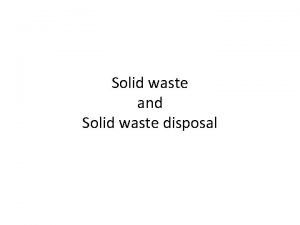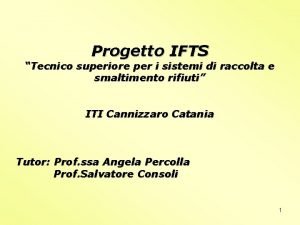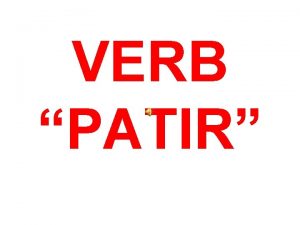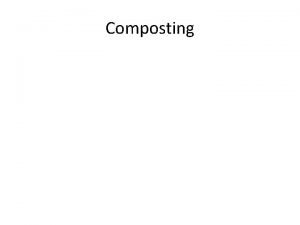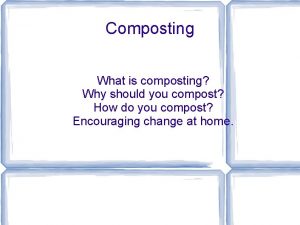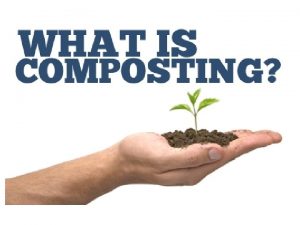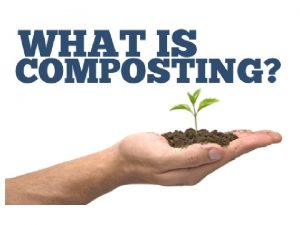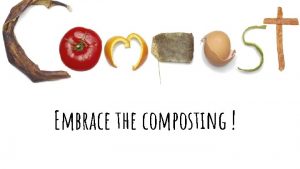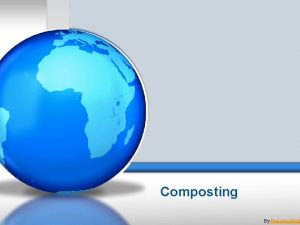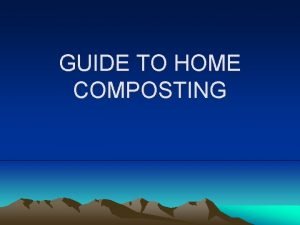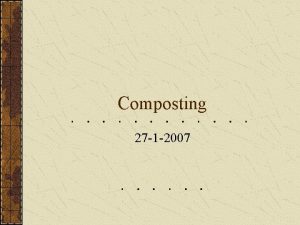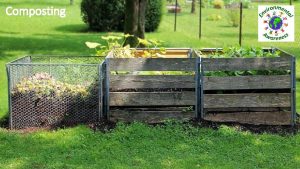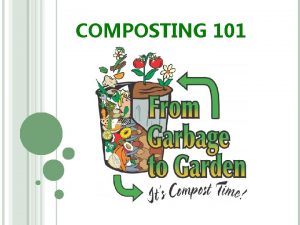Composting 101 How and Why to Compost What












- Slides: 12

Composting 101: How and Why to Compost

What Is Composting? • Composting is a natural way of recycling organic materials back into the soil in order for the cycle of life to continue. The billions of living organisms in healthy soil transform dead plants into vital nutrients for new plant growth. Since healthy plants come from healthy soil, one of the best ways you can build healthy soil in your garden or lawn is by using compost. You can easily make compost with landscape trimmings and food scraps in your own home, either inside or outside. With a small investment in time, you can improve the health and appearance of your plants, save money on fertilizers and mulch, all while preserving natural resources and protecting the health of your family and pets. • Compost is the finished product of composting, which is a dark, soil-like substance that enriches your plants with nutrients, helps retain moisture, improves soil structure, and provides a good environment for beneficial soil-living organisms- all good things for your plant babies!

Why Compost? Composting saves money Compost can be used as fertilizer, seed starter, and soil addition, saving you from buying costly and sometimes chemical ridden products from stores. If you have to pay for the amount of trash hauled, it cuts down on the amount of trash pickups. It’s Ecofriendly! 20 -30% of waste that end up in landfills is organic food waste. When food waste decomposes in the non-ideal conditions of a landfill, methane gas is released, which is a greenhouse gas that is 23 times more potent than carbon dioxide. So not only are you saving space in landfills but you are also helping combat climate change. It’s easy and beneficial Not only is composting easy and fulfilling, but your efforts will be rewarded. Compost improves soil structure and texture, increases the soil’s ability to hold both water and air, improves soil fertility, and stimulates healthy root development in plants.

• A compost pile or bin needs 4 basic ingredients: Browns, Greens, Water, and Air. • Browns • Browns provide Carbon to the compost and include paper and cardboard, dry yard waste such as leaves and twigs and branches, straw, sawdust, wood chips, old potting soil and dead house plants, or paper egg cartons. • Greens Composting Basics • • Water • Air Greens provide Nitrogen to the compost and include fresh wet yard waste, food scraps such as uncooked vegetable or fruit peels and scraps, tea bags, or coffee grounds. • Moisture is important for the decomposition process, but must be maintained at the right level. Too dry and the material can decompose too slowly, too wet and your pile can start to smell and attract pests The ideal level of moisture is that of a wrung out sponge or rag. If you were to pick up a handful and squeeze it, no more than a couple drops of water should come out. • Without the presence of air, methane is released and decomposition will occur more slowly. A compost pile should be aerated. Turning and fluffing the pile with a shovel or pitchfork should be done every time more material is added. A turning bin can also be purchased to make this easier.


Outdoor Composting If you have the space, outdoor composting allows you to compost more material than indoor composting, both in quantity and type of material. It is less restrictive in terms of what you can put into it, meaning less organic waste ends up in the landfills.

How to set up Outdoor Composting • Outdoor composting can be done in either a bin or a pile. The ideal size for either is one cubic yard (three feet across by three feet deep), but can be larger or smaller. • A pile is ideal if you are only composting yard scraps and can be reinforced by making walls of chicken wire or wood/pallets. • A bin is ideal if you also would like to compost food scraps, as it keeps out rodents or other unwanted pests. • Maintain your ratios • For the best quality compost, the carbon to nitrogen (brown to green) ratio should be 3: 1, but can vary. Just make sure it is not more than 50% nitrogen. Also remember to maintain the moisture level and aerate the pile at least once every month. • Every time you add food scraps, add them to the middle and bury with leaves or other “brown” material.

Indoor Composting Indoor composting is a great option for those without a yard or those that live in a small space, like an apartment. Also called vermiposting, indoor composting uses worms in a closed bin to break down the food. One advantage to vermiposting is since a worm can eat up to its own weight in food scraps every day, it is a faster process than outdoor composting. And as long as you maintain your ratios, you won’t stink up your house!

Setting up your Indoor Composting • First of all, choose what type of worms you are going to use, depending on what type of results you want and what type of climate you live in. Do your research, but if you are unsure or a beginner the most commonly used and most readily available type is the Red Wiggler. They are perfect for composting and easy to take care of.

Setting up Indoor Composting (cont. ) • Create an environment for your worms! • You will need 2 -3 bins of medium to large size with lids. Size can vary but ideal size is 30 in long and 12 in deep. Leave the first bin as is. This will catch all of the liquid that will come out of the compost (called compost “tea”, also very good for your plants!) For the next bin(s), drill holes in the bottom and along the top edge. This will allow excess moisture to drain out and provide aeration. Holes should also be drilled into the lid. • Layer your bins. The bottom layer should be bedding for your worms, which should be some sort of browns, i. e. shredded paper, dried leaves, etc. The second layer should be a mixture of food for the worms and rich dark soil. The third layer should once again be a layer of browns, which will help insulate and cut down on smell, cutting down on flies and pests. • Be careful what you feed them. Indoor composting is slightly more restrictive than outdoor, as your worms have restrictions as what they can and cannot eat. All fruit and vegetable scraps are fine, just watch out for garlic and onion scraps as they are too acidic for them.

Harvesting (Indoor composting cont. ) • As the worms make their way through the soil, the consume the food scraps and leave behind pure worm castings (yes, worm poop). Those castings are what you want. They are practically bursting out with all the organic nutrients plants need to thrive. Your plants will grow faster, the soil will stay aerated and retain moisture, there’s no heavy metals or chemicals, and it will never burn your plant’s roots. It’s also a natural pesticide! • There’s 2 easy ways to harvest the castings from the compost bin. When you think you have enough material in your bin, place a second bin (with holes drilled) on top of the full bin and fill it with food. Once the worms have finished eating everything in the lower bin, they will naturally make their way through the holes into the second bin to find more food. Then you can remove the product from the lower bin without moving or separating out the worms. A second method is setting up a screening system. If done properly, you can screen out the worms, cocoons, and dirt from the castings. This method is more effective for getting pure worm castings if that’s what you’re going for, but more time consuming and tedious. And in my opinion, a little dirt never hurt!

Intrigued? Links for more information! • https: //www. simplegrowsoil. com/pages/ultimate-guide-to-worm-castings • https: //www. epa. gov/recycle/composting-home • http: //howtocompost. org/cat_generalinfo. asp • https: //www. compost 411. com/ • https: //www. npr. org/2020/04/07/828918397/how-to-compost-at-home
